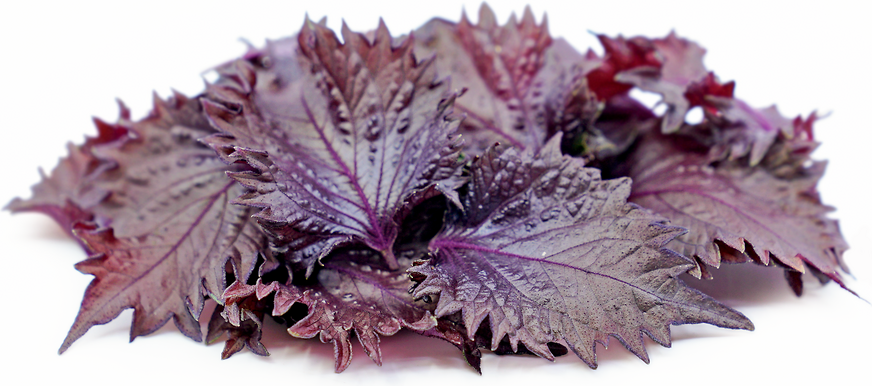


Ooba Red
Estimated Inventory, 100 ct : 11.00
This item was last sold on : 07/24/25
Description/Taste
Red ooba leaves are medium to large in size and are broad and ovate in shape, averaging 10-15 centimeters in width and 5-13 centimeters in length, though they are most often harvested at a younger, more delicate age to prevent the plant from flowering. The deep red leaves are highly pigmented, and the color is vibrant on both the surface and underside of the leaf. The leaves also have serrated edges that taper to a point and small, fine hairs running across the surface. Red ooba leaves have a tangy flavor that is a combination of mint, citrus, and anise, and an aroma that is best revealed when they are torn or crushed.
Seasons/Availability
Red ooba leaves are available in the summer.
Current Facts
Red ooba leaves, botanically classified as Perilla frutescens var. crispa, grow on an aromatic herbaceous plant and are members of the Lamiaceae, or mint family, which contains many other plants including basil, sage, and lavender. Also known as Shiso, Purple mint, Rattlesnake weed, Akajiso, Chinese basil, Jasoyup, and Perilla, Red ooba leaves are most commonly used to dye pickled plums or used as a garnish to add color to sushi and sashimi dishes.
Nutritional Value
Red ooba leaves are an excellent source of calcium, phosphorous, iron, and vitamins A, K, and C.
Applications
Red ooba leaves are used to dye umeboshi, which are pickled plums. The leaves turn the plums and the vinegary brine a bright red. These plums can be made into a paste and wrapped with additional leaves in sushi rolls known as umeshiso maki. Red ooba juice is also a common drink found in Japan and is promoted for its daily health benefits. Red ooba leaves will keep for a couple of days when wrapped in a damp paper towel and stored in a plastic bag in the refrigerator.
Ethnic/Cultural Info
In Japan, Red ooba leaves are known for their antioxidant properties and are believed to help delay aging. They are also commonly used with sushi and sashimi as they have antimicrobial properties and can help prevent indigestion from consuming raw food.
Geography/History
Red ooba leaves are native to east China where they have been found growing wild since ancient times. They were then introduced to Japan between the 8th and 9th centuries and were spread to Europe and the rest of Asia via trade routes. In the 1850s, Red ooba leaves were brought to the New World. Today Red ooba leaves can be found in fresh markets and specialty grocers in India, Japan, Korea, Thailand, China, Europe, and the United States.
Featured Restaurants
Restaurants currently purchasing this product as an ingredient for their menu.
| US Grant Hotel Grill | San Diego CA | 619-232-3121 |
| Lilo | Carlsbad CA | 619-385-0914 |
| The Kitchen at MCASD | La Jolla CA | 619-880-8719 |
| Jeune Et Jolie | Carlsbad CA | 858-231-0862 |
| Addison Del Mar | Del Mar CA | 858-350-7600 |
| Sago | Encinitas CA | 858-382-4047 |
| Choi's | San Diego CA | 858-900-1224 |
Recipe Ideas
Recipes that include Ooba Red. One
| Chopstick Chronicles |
|
Red Shiso Juice (With Perilla Leaves) |
| Small Footprint Family |
|
Fermented Shiso Leaves (Gaennip Kimchee) |













